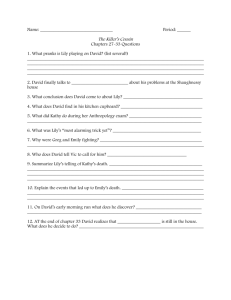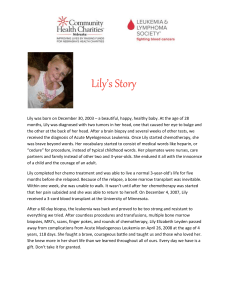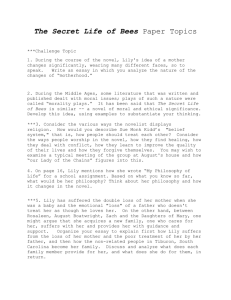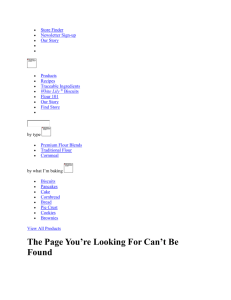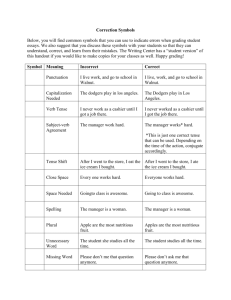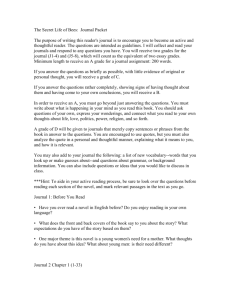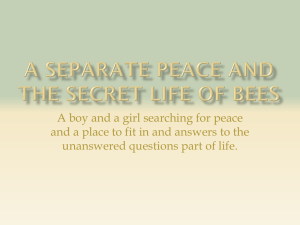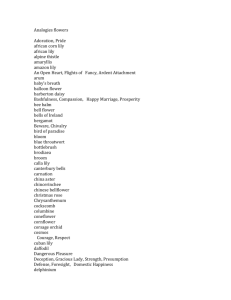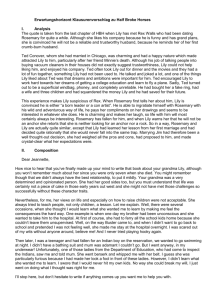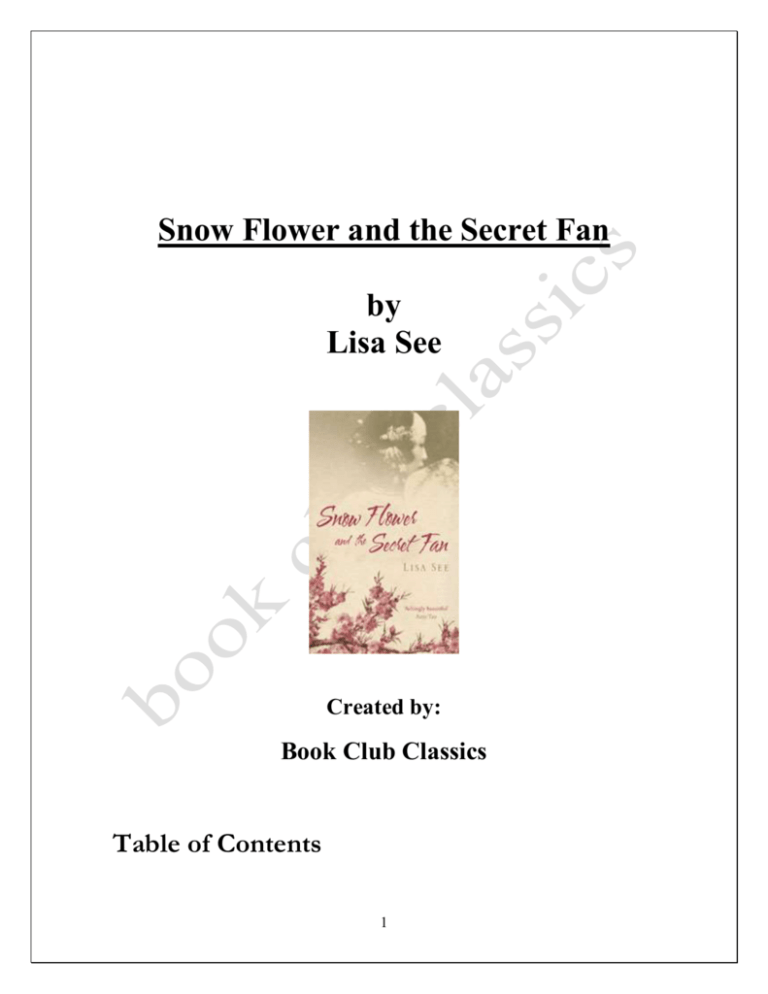
Snow Flower and the Secret Fan
by
Lisa See
Created by:
Book Club Classics
Table of Contents
1
Fast Facts:
4
Article on Nu Shu:
5
Setting:
6
Structure:
7
Vocabulary Help:
8
Author Information:
9
Character Bookmark:
10
Menu Ideas:
11 – 15
Warm-Up Ideas:
16 – 19
Discussion Questions:
20 – 23
Reviews:
24 – 25
Literary Term Help:
26 – 27
Recommended Reading:
28 - 32
Snow Flower and the Secret Fan – Fast Facts
2
Author – Lisa See
Pages – 253 pages (Random House Trade Paperback edition)
Date Published – 2005
Setting – Yongming County (present day Jiangyong County); 19th century
Point of view – First person (narrator: Lily)
Genre – Frame story (told through flashback); fiction
Issues/Conflicts – Female friendship / Marriage / Motherhood / Aging /
China / Footbinding / Regret
The Secret of Nu Shu by Lisa See
Chinese Footbinding by Candace Hutchins
A Brief History of China
Taiping Rebellion
The Woman’s Classic (read pp. 77 – 85: 2 Realms, 3 Obediences, 4 Virtues)
History of Festivals
Nu Shu by Lawrence Lo, copyright 1999 - 2007
3
Nushu is one of the most interesting and least known writing systems that I know. The words nu shu literally means
"Woman's Writing" in Chinese. As the name implies, Nushu is a writing system created and used exclusively by women in a
remote part of China. Traditional Chinese culture is male-centered and forbids girls from any kind of formal education, so
Nushu was developed in secrecy over hundred of years in the Jiangyong county of Hunan province.
Some Nushu characters are taken from Chinese, while others appear to be invented, but all are rendered in a style much
more cursive than written Chinese. In addition, the characters are "thinner" than Chinese characters, which tends to be
square-shaped. Also, like Chinese, Nushu is written from top to bottom in columns, and the columns are written from right
to left.
The following is an example of Nushu. The text on the left is Nushu, while on the right is the exact Chinese transliteration.
I left the columns for both texts in the original right-to-left order.
The passage roughly translates as "They taught her to apply makeup and comb her hair; on her head she was wearing pearls
that are shining magnificently; she is sitting like Guanyin (a Buddhist goddess) out of a Buddhist shrine".
There are only a handful of women who can still read and write in this script. In essence it is a dying language. However, no
official programs exist to preserve this incredible cultural heritage, and it would be a shame that such a symbol of women's
resilience in an oppressive environment will be lost to future generations.
Snow Flower and the Secret Fan -- Setting
4
Important Places:
Hunan Province – where story occurs
Puwei (“Common Beauty”) – Lily’s home village (near
Xiao River)
Tongkou – Snow Flower’s village; Lily’s marital home
Gaojia – Lily’s Aunt’s and Elder Brother’s wife’s village
Getan Village – Elder Sister’s new village
Guilin – Village where Lily’s husband gets salt
Shexia – Where the laotongs contract is written
Jintian (“Open Field”) – Snow Flower’s marital home
Snow Flower and the Secret Fan – Structure
5
Sitting Quietly (present – 80 years old)
Daughter Days (infant to 13 years old
o
o
o
o
o
o
Milk Years (0 – 6 years old)
Footbinding (7 – 9 years old)
The Fan
Snow Flower
Love
Learning (10 – 13 years old)
Hair-Pinning Days (15 – 19 years old)
o
o
o
o
o
Catching Cool Breezes
Beautiful Moon
The Flower-Sitting Chair
Truth (17 years old)
The Temple of Gupo
Rice-and-Salt Days (20 – 42 years old)
o
o
o
o
o
o
Sons (21 – 23 years old)
Joy and Sorrow ( 25 – 31 years old)
Into the Mountain (32 years old)
Winter (3 months)
Letter of Vituperation (33 years old)
Into the Clouds (42 years old)
Sitting Quietly
o Regret (42 – 50 years old; 80 years old)
Snow Flower and the Secret Fan – Vocabulary Help:
6
page # / word / definition
3
3
4
9
9
11
13
15
17
21
24
24
26
32
37
41
48
52
68
79
99
111
112
112
233
233
250
252
nu shu – women’s writing; phonetic, syllabary writing system from Hunan province
natal family – family one is born into
lao tong – formal, exclusive, life-long relationship between Chinese women
mou – parcel
taro – plant with edible starchy tubers; native to southeast Asia
congee – rice porridge
jin – portion
palanquins – a covered sedan chair carried on four poles
gentry – upper classes
feng shui – a Chinese system of environmental balance and harmony
rei – inner world of women
wai – outer world of men
cash – money
chi – the life force of the universe present in all living things
buluo fujia – “not settling in the husband’s home”
jinshi – a series of exams which test knowledge of the Confucian Classics
joss sticks – incense sticks burned before Chinese religious image, idol, or shrine
li – Confucian concept of ritual
enfeoffment – when a person was given land in exchange for a pledge of service
yin – feminine, passive principle exhibited in darkness, cold, or wetness
yang – masculine, active principle exhibited in light, good, and heaven
hua jiao – flower sitting chair (also a mixture of salt and pepper)
buluo fujia – period of time between marriage and when wife moves in
sanzhaoshu – 3rd day wedding book friends give to groom’s family about bride
shengyuan – budding or emerging scholar
xiucai scholar – novice scholar
juren scholar – provincial scholar
gongsheng scholar – outstanding scholar
Definitions courtesy of Encarta Dictionary and Google
Snow Flower and the Secret Fan -- Author Information
7
Lisa See was born on February 18, 1955 in Paris in 1955, but spent her childhood in Los
Angeles. Her father was one-quarter Chinese and her mother, Carolyn See, is Caucasian and
the author of five novels. Lisa has stated that she feels “Chinese in her heart” and spent
much of her childhood visiting Los Angeles’ Chinatown. She spent 12 years as the West
Coast correspondent for Publisher’s Weekly, and collaborated several times with her mother.
See’s first work, On Gold Mountain, published in 1995, is a memoir that tells the story of
four generations of her family’s Chinese-American heritage, beginning with her greatgrandfather Fong See. Her second work, The Flower Net, published in 1997, is a thriller set
in contemporary China, and was nominated for the Edgar award. In addition to Snow
Flower and the Secret Fan, See has published The Interior (1999), Dragon Bones (2003), and
Peony in Love (2007). The Organization of Chinese American Women named her the 2001
National Woman of the Year.
When writing Snow Flower and the Secret Fan, See travelled to China and did extensive
research. The character of Lily was patterned after her grandmother and grand-aunt.
See is married and has two children; they live in Los Angeles.
Information courtesy of:
Lisa See’s website and The Sacramento Bee
Interview with Lisa See
Find out her favorite books, movies and music!
Contact her at writersee@aol.com
8
Printable Bookmark! Please print and then cut to use as a reference as you read!!
Only basic information has been provided to avoid “spoilers.” The “Pg” column
indicates when each character is first introduced. Enjoy!
Character
Description
Pg
Character
Description
Pg
Lily
Peony
Mama
Narrator
Lily’s grandson’s wife
Lily’s mother
3
3
3
Uncle Lu
Master Lu
Dalang Lu
68
68
73
Lily’s son
Lily’s oldest son
4
Madame Lu
Snow Flower
Aunt
Lily’s laotong
Married to Lily’s
paternal uncle
Lily’s sister; 4 years
older
Lily’s sister; 1 year
younger
Lily’s cousin; same age
4
5
Lady Lu
Yonggang
Lily’s uncle-in-law
Lily’s father-in-law
Lily’s husband; Snow
Flower’s cousin
Lily’s grandmother-inlaw
Lily’s mother-in-law
Lily’s servant
10
Butcher
123
Snow Flower’s father
126
SF’s mother-in-law
132
Lily’s father
Lily’s brother; 6 years
older
Lily’s father’s brother
Lily’s youngest sibling
Lily’s paternal
grandmother
Village fortune teller
Local matchmaker
10
10
Snow Flower’s
husband
Snow Flower’s
father
Snow Flower’s
mother-in-law
First Son
First Son
Snow Flower’s first son
Lily’s first son
149
151
11
11
12
Second Son
Tutor
Third Son
Lily’s second son
Lily’s eldest son’s tutor
Lily’s third son
167
169
169
18
18
Jade
Spring Moon
171
171
Matchmaker from
Tongkou
Owns Shexia taro stand
Snow Flower’s mother
18
2nd Son
47
47
3rd Son
Lotus, Willow,
Plum Blosson
Lily’s daughter
Snow Flower’s
daughter
Snow Flower’s second
son
Lily’s third son
Sworn sisters from
Jintian
Elder Sister
Third Sister
Beautiful Moon
Baba
Elder Brother
Uncle
Second Brother
Grandmother
Diviner Wu
Madame Gao
Madame Wang
Old Man Zuo
Mama
10
10
Snow Flower and the Secret Fan – Menu Ideas
9
74
73
115
171
172
194
Delicious tea!
Teaspring.com – Chrysanthemum Tea!
http://www.teaforte.com/
(I would recommend Chamomile Tisane or Raspberry Nectar:
http://www.teaforte.com/our-teas/herbal-and-red-tisanes/)
10
Snow Flower and the Secret Fan – Menu!
From Lisa See’s website:
Sugared Taro:
This recipe is easy but the timing is difficult to master; unlike other desserts,
this one requires the full attention of the chef in the cooking. At best, the dried
sugar syrup should embrace the taro like a casing after the stir-fry, that’s how
the name came: fan sa, the sa, or sugar, is on the outside of the food rather
than the inside.
Ingredients:
Taro 750 g
White sugar 400 g
Water
Directions: Peel the taro. Trim the ends and sides of taro to make a rectangular
block, then slice about 2 or 3 cm thick. Stack the slices and cut into sticks 2 cm
wide.
Deep-fry with pre-heated oil until golden in color; make sure it is well-done.
Remove the taro and the oil from the wok.
Add white sugar and a little water. Cook the syrup slowly until the surface of
the liquid bubbles. Add the fried taro.
Here comes the tricky part: remove the wok from the fire immediately. Switch
on a fan in full speed and stir the taro in the liquid in the wind. Which way the
wind blow does matter in this case: blow to the taro so the syrup can solidify
during the stir-frying.
11
A dessert using a glutinous rice variety called, "sweet rice."
From Orientmag.com
Ingredients:
4 cups glutinous rice
2 cans coconut milk
1 cup white sugar
2 cups dark brown sugar
banana leaves (optional)
Preparation:
1. Steam glutinous rice in 6 cups of water in low heat.
2. Add 1 can coconut milk and white sugar 5 minutes before rice is done.
3. In a saucepan, melt brown sugar with the other can of coconut milk until
the mixture is thick.
4. Take a rectangular, medium-sized pyrex pan or baking pan.
5. Lay banana leaves, if available, on the bottom of the pan and press the
cooked rice into the pan.
6. Top with the brown sugar syrup.
7. Bake at 350 degrees in the oven for 30 minutes, or until golden brown.
8. Cool and cut into squares. Excellent for dessert or snack.
Mandarin Ducks
12
Pork Dumplings from Chinese Food DIY
Ingredients:
4 1/2 cups (500 g) flour, sifted
10 1/2 oz (300 g) lean boneless pork or mutton, minced
1 tsp salt, or to taste
6 1/2 tbsp (100 g) scallions, chopped
2 tsp ginger, chopped
1/8 tsp five-spice powder
1/2 tsp MSG (optional)
Directions:
1. Mix the flour with 3 1/2 oz (100 ml) of water to make dough. Knead until
smooth and let stand for 30 minutes.
2. To prepare the filling, mix the pork or mutton with 7 oz (200 ml) of water
and the salt. Stir in one direction until it becomes a paste. Add the scallions and
blend well. Divide filling into 100 portions.
3. Divide the dough into 4 portions and roll into long rolls. Cut each into 25
pieces. Flatten each piece and roll into 2 inches (5 cm) circles. Place 1 portion
of filling in the center of each wrapper and fold the dough over it, making a
bonnet-shaped pouch. Pinch the edges together to seal the dumpling. Repeat
until all the dough and filling are used.
4. Bring 8 cups (2 litres) of water to a boil over high heat. Add half the
dumplings. Stir them around gently with a ladle, and let the water return to a
boil. Add enough cold water to stop the boiling, then bring back to a boil.
When the water boils again, add more cold water and bring to a boil a third
time. The dumplings will be done when they float to the surface. Remove,
drain well, and serve.
13
Recipe from Zimbio.com -- Red Bean Paste Meringue Dumpling (高力豆沙)
Time needed
o
Preparation time: 20 minutes
o
Rapid cooking time: 20 minutes
Filling
o
1 can 18 oz. red bean paste
o
1/4 cup lard (optional)
Meringue
o
Egg white from 8 eggs
o
1/2 cup flour
o
1/2 cup cornstarch (or tapioca starch)
Additional Ingredients
o
5 cups vegetable oil for frying
o
Granulated sugar for garnishing
Makes 12 dumplings
How to:
o
A traditional Chinese cook would add lard to the red bean paste. Then heat
the mixture in a wok until slightly caramelized. This process definitely enhances
the flavor of the filling but in view of health concerns I often omit it.
o
Scoop out twelve equal lumps of red bean paste and arrange them on a plate.
This process will help you fill the dumpling as you start frying. Beat the egg white
until stiff peak, and then add the flour and cornstarch. Mix well until the batter
becomes smooth.
o
Heat the vegetable oil in a wok or in a deep frying pan on medium high heat.
The oil should not be too hot as the dumpling should be heated all the way
through before the outside burns. You can test the oil by dropping a small lump
of the meringue into the oil. It should sizzle slowly.
o
Fill an ice cream scoop with meringue. Drop a portion of red bean paste into
the scoop. Then cover the red bean paste with a spoonful of meringue. Drop the
battered red bean paste into the hot oil by inverting the scoop and squeezing the
handle at the same time. This should create a perfectly shaped dumpling. Moving
quickly you can cook about six dumplings in the oil simultaneously.
o
Use tongs or a pair of extra long chopsticks to turn the dumplings
occasionally to brown them evenly. It should take about 5 minutes to crisp them
thoroughly. Drain the dumplings and place them on a paper towel to absorb the
extra grease. Serve immediately on a plate and garnish with granulated sugar.
14
Snow Flower and the Secret Fan -- Setting the Mood!
Here are some ideas to set the mood and get the conversation started to help you appreciate
See’s masterpiece. Enjoy!
Introductory Game Ideas:
Recently a work was published entitled: Not Quite What I Was Planning: Six-Word Memoirs
by Writers Famous & Obscure
Examples from the book:
Nobody comes, but I still cook.
Alcoholic father, disappointed mother, funny daughter.
I’m my mother and I’m fine.
Love the men. Hate the commitment.
Since this novel is the narrator’s attempt to explain and understand her past and present, you
could ask members write their own 6 Word Memoirs! If you know each other well, you could
each write a memoir anonymously, and then try to guess which memoir goes with which
member.
Another idea:
Lily is very aware of her year of the animal and the animals of those around her.
Figure out what your animal is and decide which qualities you dis/agree with!
From: http://www.c-c-c.org/chineseculture/zodiac/zodiac.html
Rat (1912 - 1924 - 1936 - 1948 - 1960 - 1972 - 1984)
You are imaginative, charming, and truly generous to the person you love. However, you
have a tendency to be quick-tempered and overly critical. You are also inclined to be
somewhat of an opportunist. Born under this sign, you should be happy in sales or as a
writer, critic, or publicist. Some Rats: Charlotte Bronte, Truman Capote, Catherine I, Mata
Hari, Wolfgang Mozart, William Shakespeare, George Washington. They are most
compatible with people born in the years of the Dragon, Monkey, and Ox.
15
Ox (1913 - 1925 - 1937 - 1949 - 1961 - 1973 - 1985)
A born leader, you inspire confidence from all around you. You are conservative, methodical,
and good with your hands. Guard against being chauvinistic and always demanding your
own way. The Ox would be successful as a skilled surgeon, general, or hairdresser. Some
Oxen: Napoleon Bonaparte, Walt Disney, Clark Gable, Richard Nixon, Rosa arks, Sylvia
Porter, Vincent Van Gogh. They are most compatible with Snake, Rooster, and Rat people.
Tiger (1914 - 1926 - 1938 - 1950 - 1962 - 1974 – 1986)
You are sensitive, emotional, and capable of great love. However, you have a tendency to get
carried away and be stubborn about what you think is right; often seen as a "Hothead" or
rebel. Your sign shows you would be excellent as a boss, explorer, race car driver, or
matador. Some Tigers: Judy Blume, Emily Bronte, Emily Dickinson, Isadora Duncan,
Dwight D. Eisenhower, Mary Harris (Mother) Jones, Barbara McClintock, Marilyn Monroe,
Marco Polo, Beatrix Potter. Tigers are most compatible with Horses, Dragons, and Dogs
Rabbit (1915 - 1927 - 1939 - 1951 - 1963 - 1975 - 1987)
People born in the Year of the Rabbit are articulate, talented, and ambitious. They are
virtuous, reserved, and have excellent taste. Rabbit people are admired, trusted, and are
often financially lucky. They are fond of gossip but are tactful and generally kind. Rabbit
people seldom lose their temper. They are clever at business and being conscientious, never
back out of a contract. They would make good gamblers for they have the uncanny gift of
choosing the right thing. However, they seldom gamble, as they are conservative and wise.
They are most compatible with those born in the years of the Sheep, Pig, and Dog.
Dragon (1916 - 1928 - 1940 - 1952 - 1964 - 1976 - 1988)
Full of vitality and enthusiasm, the Dragon is a popular individual even with the reputation
of being foolhardy and a "big mouth" at times. You are intelligent, gifted, and a
perfectionist but these qualities make you unduly demanding on others. You would be wellsuited to be an artist, priest, or politician. Some Dragons: Louisa May Alcott, Susan B.
Anthony, Joan of Arc, Pearl Buck, Sigmund Freud, Theodore Seuss Geisel, John Lennon,
Florence Nightingale, Pat Schroeder, Mae West. They are compatible with Rats, Snakes,
Monkeys, and Roosters.
Snake (1917 - 1929 - 1941 - 1953 - 1965 - 1977 - 1989)
Rich in wisdom and charm, you are romantic and deep thinking and your intuition guides
you strongly. Avoid procrastination and your stingy attitude towards money. Keep your sense
of humor about life. The Snake would be most content as a teacher, philosopher, writer,
psychiatrist, and fortune teller. Some Snakes: Clara Barton, Liz Claiborne, Charles Darwin,
Mary Baker Eddy, Elizabeth I, Fannie Farmer, Anne Frank, Mahatma Gandhi, Ellen
Goodman, Carole King, Martin Luther King, Abraham Lincoln, Edgar Allen Poe. They are
most compatible with the Ox and Rooster.
16
Horse (1918 - 1930 - 1942 - 1954 - 1966 - 1978 - 1990)
Your capacity for hard work is amazing. You are your own person-very independent. While,
intelligent and friendly, you have a strong guard against being egotistical. Your sign
suggests success as an adventurer, scientist, poet, or politician. Some Horses: Louisa May
Alcott, Chopin, Davy Crockett, Ella Fitzgerald, Aretha Franklin, Sandra Day O'Connor,
Rembrandt, Teddy Roosevelt. They are most compatible with Tigers, Dogs, and Sheep.
Goat (1919 - 1931 - 1943 - 1955 - 1967 - 1979 – 1991)
Except for the knack of always getting off on the wrong foot with people, the Goat can be
charming company. You are elegant and artistic but the first to complain about things. Put
aside your pessimism and worry and try to be less dependent on material comforts. You
would be best as an actor, gardener, or beachcomber. Some Goats: Rachel Carson,
Michelangelo, Mark Twain, Rudolph Valentino, Barbara Walters, Orville Wright. They are
compatible with Rabbits, Pigs, and Horses.
Monkey (1920 - 1932 - 1944 - 1956 - 1968 - 1980 - 1992)
You are a very intelligent and a very clever wit. Because of your extraordinary nature and
magnetic personality, you are always well-liked. The Monkey, however, must guard against
begin an opportunist and distrustful of other people. Your sign promises success in any field
you try. Some Monkeys: Julius Caesar, Bette Davis, Annie Oakley, Eleanor Roosevelt, Betsy
Ross, Diana Ross, Elizabeth Taylor, Harry S. Truman, Leonardo da Vinci, Alice Walker.
They are most compatible with the Dragon and Rat.
Rooster (1921 - 1933 - 1945 - 1957 - 1969 - 1981 – 1993)
The Rooster is a hard worker; shrewd and definite in decision making, often speaking his
mind. Because of this, you tend to seem boastful to others. You are a dreamer, flashy
dresser, and extravagant to an extreme. Born under this sign you should be happy as a
restaurant owner, publicist, soldier, or world traveler. Some Roosters: Virginia Apgar,
Catherine the Great, Amelia Earhart, Rudyard Kipling, Groucho Marx, Peter Ustinov. They
are most compatible with Ox, Snake, and Dragon.
Dog (1910 - 1922 - 1934 - 1946 - 1958 - 1970 - 1982)
The Dog will never let you down. Born under this sign you are honest, and faithful to those
you love. You are plagued by constant worry, a sharp tongue, and a tendency to be a fault
finder, however. You would make an excellent businessman, activist, teacher, or secret
agent. Some Dogs: Cher, Winston Churchill, Bill Clinton, Dorothea Dix, Benjamin Franklin,
George Gershwin, Jane Goodall, Herbert Hoover, Shirley McLaine, Golda Meir, Lucy Maud
Montgomery, Socrates. They are compatible with those born in the Years of the Horse,
Tiger, and Rabbit.
17
Boar (1911 - 1923 - 1935 - 1947 - 1959 - 1971 - 1983)
You are a splendid companion, an intellectual with a very strong need to set difficult goals
and carry them out. You are sincere, tolerant, and honest but by expecting the same from
others, you are incredibly naive. Your quest for material goods could be your downfall. The
Boar would be best in the arts as an entertainer, or possibly a lawyer. Some Boars: Lucille
Ball, Ernest Hemingway, Mahalia Jackson, Albert Schweitzer, Elizabeth Cady Stanton. They
are most compatible with Rabbits and Sheep.
Activity Ideas:
On page 3, Lily states that “I am old enough to know only too well my good
and bad qualities, which were often one and the same.”
Which qualities of your animal suit you? Do any seem to be your “good and
bad qualities – one and the same”?
Which book club members are you supposed to be most compatible with?
How is this different from / similar to the Western concept of horoscopes?
Why are we drawn to this sort of identity-definition?
How could your time/date of birth affect your personality?
18
Snow Flower and the Secret Fan Discussion
Questions
The following questions approach the novel from a number of different angles, i.e., how the
novel functions as a work of art, how it reflects the time period, how it addresses
fundamental questions of humanity, and how it engages the reader.
A good discussion tends to start with our “heads” and end with our “hearts.” So you may
want to save subjective opinions of taste until after you have discussed the more objective
elements of the work’s merits. It is tempting to begin with, “What did everyone think?” But
if a number of people really didn’t like the novel, their opinions may derail a discussion of
the novel’s merits.
On the other hand, I recommend starting with a few accessible questions and asking every
member to respond to ensure that all voices are present and heard from the beginning. Just
a few suggestions! Enjoy…
Warm up questions:
Normally we tend to empathize with a first person narrator, but Lily wants us to
empathize more with Snow Flower. Did you empathize with Lily or Snow Flower
more? Which characters did you dislike the most and why?
Which section did you find most compelling? Why?
Did any sections drag?
1)Reread the first few sentences:
“I am what they call in our village ‘one who has not yet died’ – a widow, eighty years
old. Without my husband, the days are long. Only the past interests me now. After
all this time, I can finally say the things I couldn’t when I had to depend on my natal
family to raise me or rely on my husband’s family to feed me. I have a whole life to
tell; I have nothing left to lose and few to offend…I am old enough to know only too
well my good and bad qualities, which were often one and the same. For my entire
life I longed for love. I knew it was not right for me – as a girl and later as a woman –
to want to expect it, but I did, and this unjustified desire has been at the root of every
problem I have experienced in my life.” (1)
This novel is called a “frame story” because the main narration is a flashback, framed by the
narrator’s present situation. How did organizing the story in this manner affect your first
impressions of this novel? Did the first section make you want to read the novel?
Lily is attempting to justify her life -- do you agree with her assertion that her longing for
love was the root of every problem she experienced? What other qualities (good and bad)
does Lily possess that are also to blame for past problems?
19
2) In the first section, Lily presents her relationship with her mother:
“I dreamed that my mother would notice me and that she and the rest of my family
would grow to love me. To win their affection, I was obedient – the ideal
characteristic for someone of my sex – but I was too willing to do what they told me
to do. In our country, we call this type of mother love teng ai… The first means pain;
the second means love. That is a mother’s love…” (3)
How would you characterize Lily’s relationship with her mother? They were hard on each
other at times – who were you more empathetic towards and why?
3) Lily presents different types of love:
“For me, love was such a precious possession that I couldn’t share it with anyone
else, and it eventually cut me away from the one person who was my same…I am
still learning about love. I thought I understood it – not just mother love but the love
for one’s parents, for one’s husband, and for one’s laotong. I’ve experienced the
other types of love – pity love, respectful love, and gratitude love. But looking at our
secret fan with its messages written between Snow Flower and me over many years, I
see that I didn’t value the most important love – deep-heart love.” (5)
Lily is told that “A laotong relationship is made by choice for the purpose of
emotional companionship and eternal fidelity. A marriage is not made by choice and
has only one purpose – to have sons.” (43)
Did Lily choose her same? How did you react to not only an arranged marriage, but to the
idea of an arranged “best friend”? What could be possible benefits of this tradition?
4) Arthur Golden, the author of Memoirs of a Geisha, described Lily as “a woman shaped
by suffering forced upon her from her earliest years, and of the friendship that helps her to
survive.” Which woman is shaped by her suffering more and receives more sustenance
from the laotong relationship – Lily or Snow Flower?
5) According to Lily, the expectations of women in the 29th century China were to be
obedient (to your father, then husband, then son) and to have the smallest “golden lilies.”
Why were small feet valued so much? If you were asked to identify the two most important
expectations of women in the U.S. in the twenty-first century, how would you answer?
6) Throughout history, many patriarchal societies have ordained separate spheres for men
and women – in this novel, Lily’s domain was the “upstairs women’s rooms”: “What I know
is embroidery, weaving, cooking, my husband’s family, my children, my grandchildren, my
great-grandchildren, and nu shu.” (4) What are some benefits of dictating separate spheres
for the genders?
20
7) Notice that the nu shu language is a phonetic language and is based on tone and context.
How is emphasizing tone and context uniquely feminine? How does this lead to Lily and
Snow Flower’s misunderstanding?
8) Few of the men have names (except Lily’s husband) – yet most of the women do,
including Lily’s daughter and servant. Why do you think See chose to not name most of the
men?
9) Before Snow Flower’s home situation is revealed, had you guessed that something was
not right? What were your clues?
10) Other than obedience, notice how the value and status of a woman was based mostly on
circumstances beyond her control (parents, size of feet, number of sons). Do we still value
women based on qualities beyond their control?
11) On page 140, Lily observes: “As in most marriages, the most important person for me to
build a relationship with was my mother-in-law.” Is that still true today?
12) At one point, Lily states: “Everything that had happened in Snow Flower’s life – the
reality of her childhood, her terrible marriage, and now this – was beyond my understanding.
I had just turned twenty-one. I had never experienced real misery, my life was good, and
these two things left me with little empathy.” (166) Do you agree that we need to have
experienced pain ourselves before we are able to understand another’s?
13) How did you respond to the Catching Cool Breezes section (Lily and Snow Flower’s
physical relationship)?
14) When asked about the footbinding sections in the novel, Lisa See responded:
“Many preconceptions and misconceptions surround footbinding. It’s easy to
equate it with the horrific practice of female genital mutilation in Africa, the tradition
of shouding women in burkas in the Middle East, or even the strange, peculiar, often
extreme cosmetic surgery treatments that so many American women seek. But I
didn’t want to put my contemporary Western values on the practice. Rather, I
wanted to write about footbinding from the perspective of the women and girls who
had grown up with it. For me, this brought up a lot of questions: How does a
culture decide what’s beautiful? How does our worth as women change according to
that sense of beauty? …What would it mean to have achieved the socially accepted
and acknowledged beauty of three-inch feet yet be hobbled or possibly crippled in
the process?”
How do you react to See’s questions? How do you feel about See including cosmetic
surgery with footbinding?
21
15) Lily ends her tale with the following words:
“…if the dead continue to have the needs and desires of the living, then I’m reaching
out to Snow Flower and the others who witnessed it all. Please hear my words.
Please forgive me.”
Since Lily’s primary audience is Snow Flower, how do you think Snow Flower would
respond? Which parts would affect her most profoundly – which parts would struggle with?
Wrap up Questions!
1.
2.
3.
4.
5.
Would you recommend the book to others? (Why/not)
If you could change anything, what would it be?
Do you believe this novel was effective for book club discussion?
Would you read a sequel of this novel?
Would you see this novel if made into a movie?
22
Snow Flower and the Secret Fan – Reviews
Honor Book of the Adult Literature of the Asian/American Award for
Literature.
2006 Book Sense Honor Book in Adult Fiction.
Southern California Booksellers Association Award for Best Novel of 2005
New York Times Fiction Paperback
23 weeks total / 1 week at # 22
first recorded Mar 12, 2006 at # 27
last recorded Oct 15, 2006 at # 22
Los Angeles Times Fiction Paperback
30 weeks total / 8 weeks at # 1
first recorded Mar 12, 2006 at # 1
last recorded Oct 08, 2006 at # 2
USA Today Top 50
6 weeks total / 1 week at # 31
first recorded Aug 31, 2006 at # 44
last recorded Oct 05, 2006 at # 35
Barnes & Noble College Paperback Fiction
6 weeks total / 1 week at # 6
first recorded Aug 04, 2006 at # 8
last recorded Sep 08, 2006 at # 9
Borders Quality PB Fiction
14 weeks total / 4 weeks at # 2
first recorded Mar 11, 2006 at # 10
last recorded Oct 07, 2006 at # 2
23
Reviews!
From the Los Angeles Times:
See's translucent prose style gleams with the beauty of 19th century Chinese culture but also
makes us burn with indignation at its sexist ugliness and injustice. By bringing the secret
world of these Chinese women into vivid relief, See has conjured up an alien world that is
the better for being lost. Read the full review.
From the Washington Post:
Through See's careful, detailed descriptions of life in a remote 19th-century Chinese village,
we experience a world where women spend their days in upstairs chambers, kowtowing to
elders, serving tea and communicating in nu shu. She reveals to us the horrors of foot
binding (foot bent back, bones broken and reshaped), a young girl's innocent dreams of life
in a new home mingled with fears of being married off to a stranger, and the obsession with
bearing sons. The wonder of this book is that it takes readers to a place at once foreign and
familiar -- foreign because of its time and setting, yet familiar because this landscape of love
and sorrow is inhabited by us all. Snow Flower and the Secret Fan is a triumph on every
level, a beautiful, heartbreaking story. ·Read the full review
2 Women Cling in a Culture of Bound Feet (New York Times review)
The exotica, fetishism and soap opera in Lisa See's novel of 19th-century China, "Snow
Flower and the Secret Fan," make for a fragrant mix. Or at least they make a learning
experience out of what might otherwise be more frankly perverse. The book describes a
very intense friendship between two women, Lily and Snow Flower, who are linked
together more closely than lovers. The only bonds tighter than the ones uniting these
two souls are the agonizing ties applied to their precious young feet.
The Elegant Variation review
If there is one truth that can be gathered from Lisa See’s beautiful and, at times, disturbing
novel, Snow Flower and the Secret Fan, it is that no matter how oppressive a society may be
toward a portion of its population (in this case, Chinese girls and women of the early 1800s),
the victims of such oppression will find a way to humanize their existence by searching for
love and even creating art. The other truth one can gather is that it takes a talented and
discerning writer such as See to shape extensive historical research into characters and
narrative that ring true.
For full reviews of Snow Flower and the Secret Fan, click: More reviews!
24
Snow Flower and the Secret Fan – Literary Terms
Exposition – the introduction of the setting, characters, and conflict(s) at the beginning of a
novel. Our first impressions are greatly influenced by our enjoyment and impressions of the
first chapter, so after finishing a novel, consider skimming the first few paragraphs again to
see how the author shaped and influenced your first impressions. Notice how See’s first
person narrator immediately states her intention in the first sentence and the last sentence of
the first paragraph: “I am what they call in our village ‘one who has not yet died’ – a widow,
eighty years old…I have a whole life to tell; I have nothing left to lose and few to offend.”
Diction – word choice. Notice See’s word choice and how that influences your reading
speed as well as enjoyment level. The “diction” of nu shu is dependent on tone and context
and is therefore easy to misinterpret.
Syntax – style of sentence structure. Notice how the author’s crafting of syntax affects your
engagement as a reader. Complexity of syntax does not determine literary merit – the
pairing of syntax to meaning does.
Tone – author’s attitude toward subject. Think “tone of voice.” Tone is created through
diction and can be very subtle, but is extremely important. If you misinterpret the tone, you
most likely misinterpret the meaning or theme of the narrative. Correctly interpreting the
meaning of nu shu is dependent on correctly interpreting the tone and context: “Unlike
men’s writing, a nu shu character does not represent a specific word. Rather, our characters
are phonetic in nature. As a result, one character can represent every spoken word with that
same sound…much care has to be taken to make sure we do not misinterpret meaning.”
Lily’s inability to do this leads to the climax of the novel.
Mood – emotional atmosphere of novel. Mood is considered an aspect of the setting (time,
place, atmosphere). When we read a novel, we “read ourselves,” so think about what type of
mood your favorite novels tend to have and how different moods may influence your
enjoyment level. Notice how the mood shifts as the narration unfolds.
Theme – main idea that runs throughout and unifies the novel. Theme should be stated as
a complete thought and not one word, which would instead be a topic of the novel: instead
of “friendship” or “family” consider what the author is saying about the nature of
friendship or family. In complex literature, themes are frequently not “morals” of the novel;
they may or may not represent the ideal.
25
Irony – the opposite of what is expected. Dramatic irony is when the reader has more
information than the character does, providing the reader with an all-knowing perspective.
Situational irony is when a situation turns out differently than expected. Verbal irony is
when the speaker means the opposite of what is said, so correctly interpreting tone becomes
crucial to the reader’s understanding of the events and particularly of the themes. An
example of situational irony in this novel occurs when Snow Flower and Lily educate each
other to accept futures very different from their respective pasts: Snow Flower teaches Lily
how to become a “lady” while Lily teaches her how to endure a much rougher life.
Symbolism – when an element of the story (object, character, color, etc.) is both literally
present in the novel and has significance or represents something beyond itself. Lily states
that “Foot size would determine how marriageable I was. My small feet would be offered as
proof to my prospective in-laws of my personal discipline and my ability to endure the pain
of childbirth, as well as whatever misfortunes might lie ahead. My small feet would show the
world my obedience to my natal family, particularly to my mother, which would also make a
good impression on my future mother-in-law. The shoes I embroidered would symbolize to
my future in-laws my abilities at embroidery and thus other house learning.”
Foil – when two characters contrast each other. The characters do not need to be enemies
– or even be aware of one another. Lily and Snow Flower, while “old sames” are actually
foils: “Snow Flower was born a horse too…although we were old sames, both of us born
under the sign of the hors, my feet were always on the ground – practical, loyal, and
obedient – while her horse spirit had wings that wanted to soar and fought against anything
that might rein her in, despite having a mind that sought beauty and refinement.” (131).
Imagery – the use of language that appeals to the senses. Lily employs vivid imagery when
trying to erase Snow Flower from her mind: “Inside my head I had an army of brushes with
black ink, obliterating the thoughts and memories that kept popping up. I called upon the
hardness of the bronzes in the ancestral temple, the hardness of ice in winter, and the
hardness of bones dried out under an unrelenting sun to give me strength.” (225)
Once an image symbolizes a deeper meaning, it becomes a metaphor or simile. For
example, when Lily remembers her bad times, she thinks, “In bad times my heart was as
strong as jade.” (4) The strong, hard nature of the gem has greater significance to Lily since
she recognizes aspects of her nature in it – and eventually names her only daughter Jade. In
the earlier quote, “army of brushes” is an example of a metaphor.
26
Snow Flower and the Secret Fan – Further reading!
The following selections focus on female relationships, as well
as other cultures.
A Thousand Splendid Suns by Khaled Hosseini
A Thousand Splendid Suns is a breathtaking story set against the volatile events of
Afghanistan’s last thirty years—from the Soviet invasion to the reign of the Taliban to the
post-Taliban rebuilding—that puts the violence, fear, hope, and faith of this country in
intimate, human terms. It is a tale of two generations of characters brought jarringly together
by the tragic sweep of war, where personal lives—the struggle to survive, raise a family, find
happiness—are inextricable from the history playing out around them.
Propelled by the same storytelling instinct that made The Kite Runner a beloved classic, A
Thousand Splendid Suns is at once a remarkable chronicle of three decades of Afghan history
and a deeply moving account of family and friendship. It is a striking, heart-wrenching novel
of an unforgiving time, an unlikely friendship, and an indestructible love—a stunning
accomplishment.
From KhaledHosseini.com
BookClubClassics kit available for this novel for only $15.00!
27
The Cairo Trilogy by Naguib Mahfouz
"The trilogy recounts, with Tolstoyan assurance, the lives, marriages and disruptive
extramarital passions of a Muslim family of the middling merchant class.(...) For the
American reader, Mahfouz's writing produces a simultaneous double-reading. One gets
caught up in this Muslim family's concerns. Scandals produced by the sexual obsessions of
father and sons (...) threaten the private stability of the patriarchal household, the public
respectability all-important to its perilous social standing, indeed the stability of traditional
Muslim structures themselves. Mahfouz is so absorbed in each scene, so effortlessly able to
assume with the great story-tellers that the tale he is telling is the only tale worth hearing at
the moment, that the reader, as it were, must become a member of the family." - George
Kearns, The Hudson Review
28
The Secret Life of Bees by Sue Monk Kidd
From Publishers Weekly
Honey-sweet but never cloying, this debut by nonfiction author Kidd (The Dance of the
Dissident Daughter) features a hive's worth of appealing female characters, an offbeat plot
and a lovely style. It's 1964, the year of the Civil Rights Act, in Sylvan, S.C. Fourteen-yearold Lily is on the lam with motherly servant Rosaleen, fleeing both Lily's abusive father T.
Ray and the police who battered Rosaleen for defending her new right to vote. Lily is also
fleeing memories, particularly her jumbled recollection of how, as a frightened four-year-old,
she accidentally shot and killed her mother during a fight with T. Ray. Among her mother's
possessions, Lily finds a picture of a black Virgin Mary with "Tiburon, S.C." on the back so,
blindly, she and Rosaleen head there. It turns out that the town is headquarters of Black
Madonna Honey, produced by three middle-aged black sisters, August, June and May
Boatwright. The "Calendar sisters" take in the fugitives, putting Lily to work in the honey
house, where for the first time in years she's happy. But August, clearly the queen bee of the
Boatwrights, keeps asking Lily searching questions. Faced with so ideally maternal a figure as
August, most girls would babble uncontrollably. But Lily is a budding writer, desperate to
connect yet fiercely protective of her secret interior life. Kidd's success at capturing the
moody adolescent girl's voice makes her ambivalence comprehensible and charming. And it's
deeply satisfying when August teaches Lily to "find the mother in (herself)" a soothing
lesson that should charm female readers of all ages. (Jan. 28)Forecast: Blurbs from an
impressive lineup of women writers Anita Shreve, Susan Isaacs, Ursula Hegi pitch this book
straight at its intended readership. It's hard to say whether confusion with the similarly titled
Bee Season will hurt or help sales, but a 10-city author tour should help distinguish Kidd.
Film rights have been optioned and foreign rights sold in England and France.
Copyright 2001 Cahners Business Information, Inc.
29
The Faith Club by Ranya Idliby, Suzanne Oliver, and Priscilla Warner
From Publishers Weekly
In the wake of 9/11, Idliby, an American Muslim of Palestinian descent, sought out fellow
mothers of the Jewish and Christian faiths to write a children's book on the commonalities
among their respective traditions. In their first meeting, however, the women realized they
would have to address their differences first. Oliver, an Episcopalian who was raised
Catholic, irked Warner, a Jewish woman and children's author, with her description of the
Crucifixion story, which sounded too much like "Jews killed Jesus" for Warner's taste.
Idliby's efforts to join in on the usual "Judeo-Christian" debate tap into a sense of alienation
she already feels in the larger Muslim community, where she is unable to find a progressive
mosque that reflects her non–veil-wearing, spiritual Islam. The ladies come to call their
group a "faith club" and, over time, midwife each other into stronger belief in their own
respective religions. More Fight Club than book club, the coauthors pull no punches; their
outstanding honesty makes for a page-turning read, rare for a religion nonfiction book.
From Idliby's graphic defense of the Palestinian cause, Oliver's vacillations between faith and
doubt, and Warner's struggles to acknowledge God's existence, almost every taboo topic is
explored on this engaging spiritual ride. (Oct. 3)
Copyright © Reed Business Information, a division of Reed Elsevier Inc. All rights reserved.
BookClubClassics kit available for this novel for only $15.00!
30
The Country Girls trilogy by Edna O’Brien
The Country Girls is the first book of a trilogy, and it leaves the reader panting for the next installment in the
tragicomic life of Caithleen and her somehow sometimes friend Baba Brennan.
Baba is a vain, grasping girl who needs friend like Caithleen, someone who broods about
the feelings of others and gets good grades as well. Each time Baba hurts or betrays
Kate, you want our heroine to get finally angry, but they are locked in a dance much like
the one depicted on the front cover of this pretty little book. Baba is the more
sophisticated, her mother an acknowledged town slut, and Caithleen is the child of a
noted drunkard and a mother who drowned mysteriously in a tragic scene with the merest hint of debauchery:
“I knew that Mama would never have a grave for me to put flowers on. Somehow she was more dead than
anyone I had ever heard of.”
Baba manages to lead naïve Caithleen into all sorts of devilment, including a final break from the convent
school where Caithleen’s won a scholarship (and Baba’s followed not by cleverness but with her parent’s
money). They disgrace themselves utterly by dropping a filthy note scrawled on a religious card where the nuns
are sure to find it -- Baba’s idea, though it is the easily-led Caithleen who takes the brunt of it, being told by the
Reverend Mother, “Your mind is so despicable that I cannot conceive how you have gone unnoticed all these
years.”. Together then, the girls go to Dublin where they begin life, in their late teens, as free women learning
the world.
Caithleen seeks to please and has longings for a married man known as “Mr. Gentleman” who is clearly
determined to seduce her. Baba seeks to exploit others and steals cakes, tomatoes and anything she can get her
claws on while trysting with unromantic middle-aged men because “Young men have no bloody money.”
When they go out on a double date she admonishes Kate, “Will you, for Chrissake, stop asking fellers if they’ve
read James Joyce’s Dubliners?”
Kate nourishes a yen for true romance, which she’s sure she’ll find with the mysterious Mr. Gentleman with his
French airs, while Baba, ever the pragmatist, says of their boring escorts, “Think of the dinner…lamb and mint
sauce.”
When we are forced to leave these delightful young women, Baba has begun a six-month stay at a tuberculosis
sanatorium. “She left the blue necklace on my bed with a note. It said: To Caithleen in remembrance of all the
good times we had together. You’re a right-looking eejit.” Four years to the day after the death of her mother,
Caithleen is preparing to meet Mr. Gentleman in Dublin from whence they will sail to Venice for a proper
romance, she in a lilac-colored nighty borrowed from the landlady and smelling of camphor. He does not show
up. http://www.curledup.com/countryg.htm
31
32

